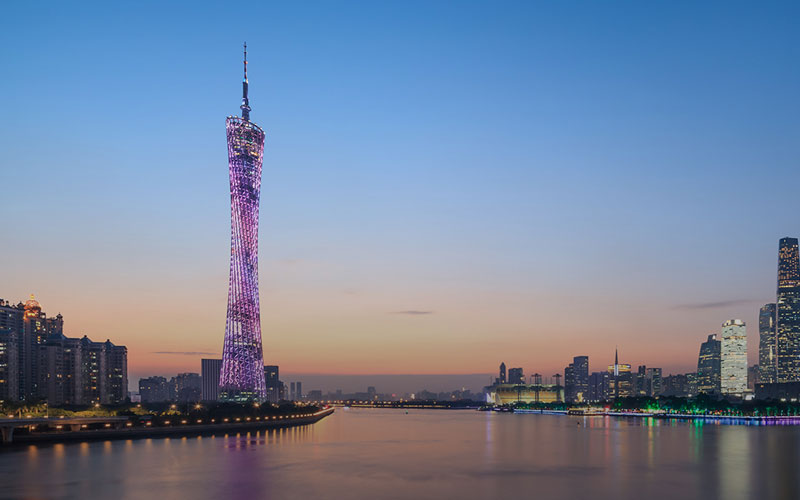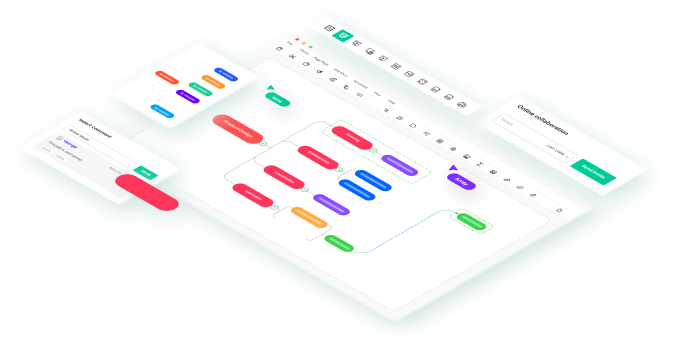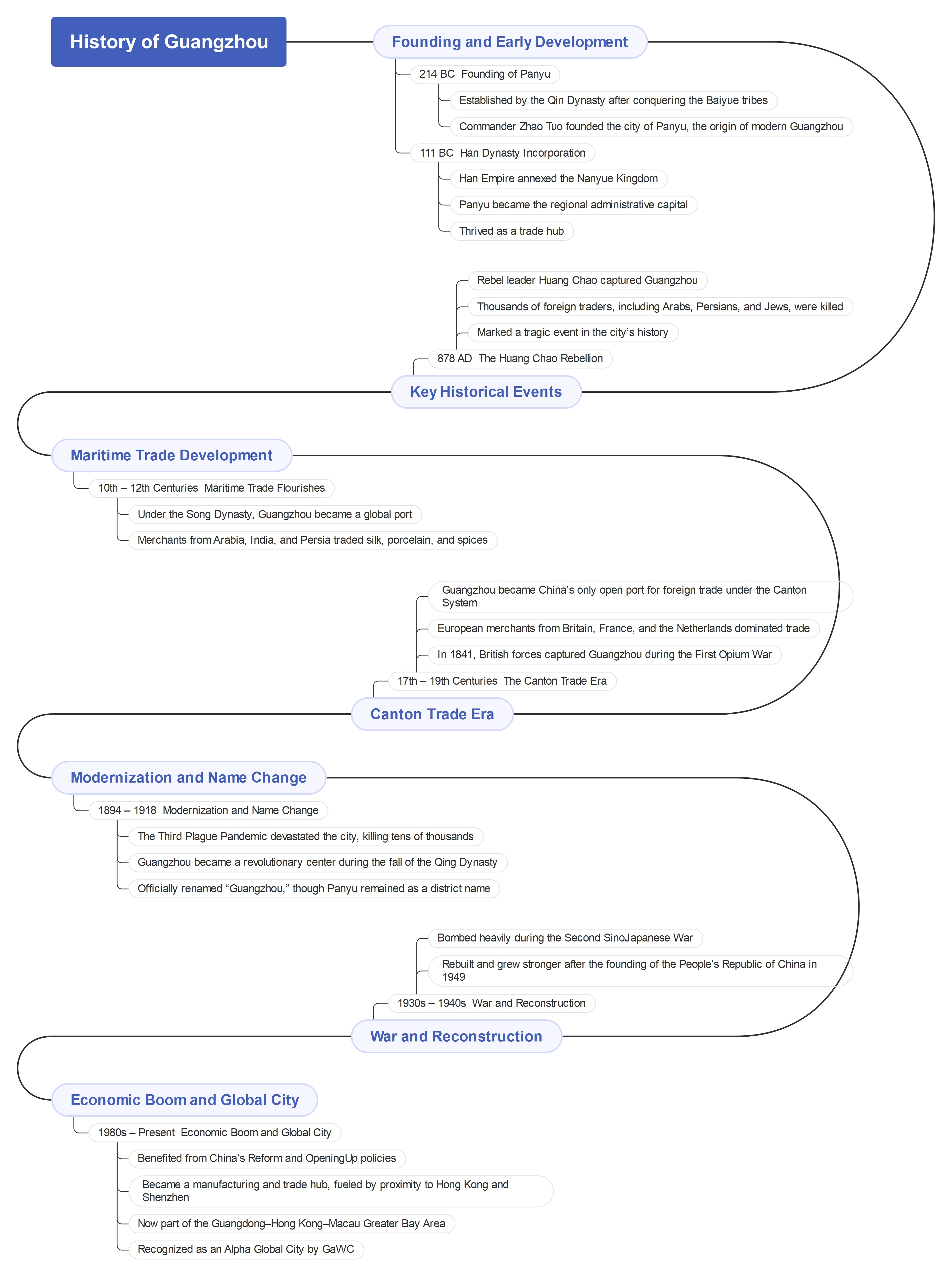Guangzhou is one of China’s largest and most economically important cities. Located along the Pearl River, it has always been a major commercial hub in southern China. Today, it serves as the capital of Guangdong Province in the People’s Republic of China.
With a population of over eighteen million in the city proper and more than sixty-five million in the Greater Bay Area, Guangzhou is a key part of the Pearl River Delta Megacity Region. It is recognized as an Alpha-level Global City by the Globalization and World Cities Research Network (GaWC) because of its global influence in trade, manufacturing, and culture.
However, this thriving metropolis has a long and fascinating past that stretches back more than two thousand years. The timeline below provides an overview of how the city developed from its early beginnings into one of China’s most dynamic urban centers.
In this article
History of Guangzhou
The history of Guangzhou begins in 214 BC during the Qin Dynasty. After conquering the Baiyue tribes in the south, military commander Zhao Tuo established the city of Panyu. This marked the formal founding of what would later become Guangzhou.
214 BC – The Founding of Panyu
The history of Guangzhou begins in 214 BC during the Qin Dynasty. After conquering the Baiyue tribes in the south, military commander Zhao Tuo established the city of Panyu. This marked the formal founding of what would later become Guangzhou.
111 BC – Incorporation into the Han Empire
In 111 BC, the Han Dynasty defeated the Nanyue Kingdom and incorporated it into the Chinese Empire. Panyu became the administrative center of the region and developed into a growing trade and political hub.
878 AD – The Huang Chao Rebellion
During the Tang Dynasty, Guangzhou suffered a major tragedy when the rebel leader Huang Chao captured the city in 878 AD. Many foreign merchants, including Arab, Persian, and Jewish traders, were killed during the rebellion.
10th to 12th Centuries – The Age of Maritime Trade
Under the Song Dynasty, Guangzhou became one of China’s leading maritime ports. Traders from Arabia, Persia, and India arrived to exchange goods such as silk, porcelain, and spices. The city flourished as an international trading center connecting China to the wider world.
17th to 19th Centuries – The Canton Trade Era
By the seventeenth century, Guangzhou was the main port for China’s foreign trade. During the Qing Dynasty, the Canton System restricted international trade to this city alone. European merchants, including those from Britain, France, and the Netherlands, established trading houses along the Pearl River. In 1841, during the First Opium War, British forces captured Guangzhou in the Battle of Canton. This marked a significant shift in China’s relationship with the West.
1894 to 1918 – Disease and Change
In 1894, Guangzhou was struck by the Third Plague Pandemic, which claimed tens of thousands of lives. Despite this, the city continued to modernize. It became a center of revolutionary movements, including the uprisings that helped overthrow the Qing Dynasty. Around this time, the city’s name officially became Guangzhou, although Panyu remained as a district name.
1930 to the Present Time
During the Second Sino-Japanese War, Guangzhou suffered heavy bombings but was later rebuilt. After the founding of the People’s Republic of China in 1949, the city developed rapidly. From the 1980s onward, China’s Reform and Opening-Up policies under Deng Xiaoping transformed Guangzhou into a major manufacturing and export center. Its proximity to Hong Kong and Shenzhen helped it attract foreign investment and talent. Today, Guangzhou is a key global center for industry, trade, and culture. It hosts the world-famous Canton Fair, one of the largest trade exhibitions, and continues to be a bridge between China and the rest of the world.
Fun Facts About Guangzhou

- Known to Westerners as Canton
- Often called the City of Flowers and Goat City because of its lush scenery and ancient legends
- The Port of Guangzhou is one of the busiest cargo ports in the world
- Renowned for Cantonese cuisine and thousands of restaurants across the city
- Home to both ancient temples and striking modern architecture, showing the blend of old and new
Create a Timeline to Better Understand History
Benefits of Creating a Timeline
Creating a timeline is one of the most effective ways to understand and visualize historical progress. It allows us to see how key events connect, overlap, and influence one another through time. When studying a city like Guangzhou, a timeline highlights how centuries of trade, culture, and conflict have shaped its identity as a modern global hub.
Timelines also make complex information easier to digest. Instead of memorizing isolated dates, learners can recognize cause-and-effect patterns, such as how Guangzhou’s location on the Pearl River encouraged international commerce or how political shifts affected its development. For educators and researchers, timelines serve as valuable visual aids that can simplify communication and spark curiosity. Whether used in classrooms, reports, or presentations, they transform historical narratives into clear, engaging stories that connect the past with the present.
How to Make a Timeline
Step 1 - Define Your Focus
Decide what story you want your timeline to tell. In this case, the topic is “The History of Guangzhou (214 BC – Present)”. Determine how detailed you want it to be, whether to cover the entire history or highlight specific eras like trade expansion or modern reforms.
Step 2 - Gather Key Events
Research reliable sources such as Encyclopaedia Britannica, Wikipedia, and ChinaKnowledge.de for verified historical data. Collect significant milestones, for example:
- 214 BC – Founding of Panyu (ancient Guangzhou) during the Qin Dynasty.
- 111 BC – Becomes the capital after the Han conquest of Nanyue.
- 878 CE – Huang Chao rebellion and massacre of foreign traders.
- 17th–19th centuries – Rise of the port of Canton as a major trade hub.
- 1841 – The British captured Guangzhou during the First Opium War.
- 1918 – Officially named Guangzhou.
- 1980s–Present – Rapid modernization and economic growth.
Step 3: Organize Chronologically
Arrange events by period: ancient (Qin–Han), medieval (Tang–Song), early modern (Qing–Republic), and contemporary (1949–today). Group-related themes such as trade, politics, and urban development.
Step 4: Choose a Layout
Pick a layout that suits your narrative.
- A curved timeline works best for long histories like Guangzhou’s.
- A horizontal timeline fits shorter or thematic sequences.
Use color codes for dynasties, and icons for political, economic, or cultural events.
Step 5: Add Descriptions and Visuals
Write summaries for each milestone, one or two lines per event. Include small visuals like flags, landmarks, or maps to add visual interest.
Step 6: Review and Refine
Check dates and facts for accuracy. Ensure events are evenly spaced and easy to follow. Adjust colors or labels so the flow of time and key transitions are clear.
Tool Recommendations
There are many tools available for building timelines, including digital and traditional options. We recommend EdrawMind, which was used to create the timeline above. Its flexible templates, curved layouts, and visual features make organizing historical information simple and engaging.
Conclusion
Guangzhou has been one of South China’s most important cities for over two thousand years. Its history as a center of trade, politics, and culture reflects China’s connection with the outside world. Over the centuries, it has grown from the small city of Panyu into a global powerhouse. Today, Guangzhou stands as a modern metropolis that continues to shape the future of southern China and beyond.







